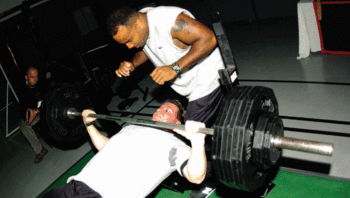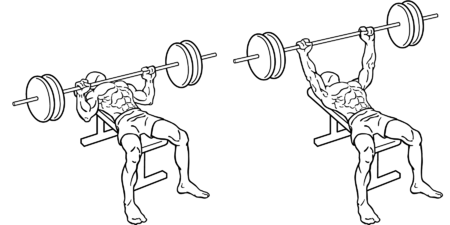- Bench press
-
The bench press is an exercise of the upper body. For bodybuilding purposes, it is used to stimulate the pectorals, deltoids, and triceps. While on his or her back, the person performing the bench press lowers a weight to the level of the chest, then pushes it back up until the arm is straight. The exercise focuses on the development of the pectoralis major muscle as well as other supporting muscles including the anterior deltoids, serratus anterior, coracobrachialis, scapulae fixers, trapezii, and the triceps. The bench press is one of the three lifts in the sport of powerlifting and is used extensively in weight training, bodybuilding, and other types of fitness training to develop the chest.
Contents
Form
A barbell bench press starting position has the weight lifter lying on a bench, with the shoulder blades pinched together to create a stable, solid base for the press, also used in powerlifting to reduce the range of motion. The lifter keeps his feet flat on the ground or at end of the bench, with the buttocks always in contact with the bench. Powerlifters will arch their back to provide greater stability and to reduce their range of motion allowing them to move more weight. Different grip widths can be used to increase or decrease the range of motion and place more or less emphasis on particular muscles. The movement begins by lifting the bar off the uprights and lowering it until the bar is motionless on the chest before being pressed under control to the start position. After the desired number of repetitions, the weight lifter returns the bar to the uprights. Because the load on the bar above the chest can be heavy, a spotting partner increases the safety of the movement.[1]
Muscles
A generic bench press utilizes pectoralis major, anterior deltoid, long head of triceps brachii and coracobrachialis to flex the shoulder. It also uses predominately triceps brachii and anconeous to produce elbow extension. Wider hand spacing creates larger emphasis on shoulder flexion and narrower hand spacing utilises more elbow extension. Because of this a wider spacing is associated with working pectorals and narrower hand spacing is associated with working triceps.
In addition to the major phasic (dynamic) muscles the bench press also uses tonic (stabilising) muscles: scapular stabilisers (serratus anterior, middle and inferior trapezius), humeral head stabilisers (rotator cuff muscles), and core (transverse abdominis, obliques, multifidus, erector spinae, quadratus lumborum)
Variations
Bench press works primarily to build the chest. Variations work different subgroups of muscles, or work the same muscles in different ways:
Angle
- The flat bench press works both portions of the pectoralis major muscle but focuses on the lower (sternal head) as well as the anterior deltoid muscle. If the term 'bench press' is used, it is generally assumed to be a flat bench press.
- An incline elevates the shoulders and lowers the pelvis as if reclining in a chair; this variation emphasizes anterior deltoids and emphasizes the upper (clavicular head) of the pectoralis major.
- A decline bench press elevates the pelvis and lowers the head, and emphasizes the lower portion of the pectoralis major.
Stability
A lifter can do certain things to destabilize their lifting. Examples include lifting on a Swiss ball, using dumbbells instead of a barbell, or not using the legs to stabilize oneself on the bench. Narrowing the leg position or bringing the feet onto the bench are other examples of ways a lifter can destabilize the movement, and lessen the amount of weight they can safely press.
Hand position
- Varying the width of the grip can alter the mechanics of the movement. The longest range of motion is produced, and the most muscles recruited, when a standard grip is used in which the forearms are vertical at the bottom of the movement. A wider grip shortens the range of motion at the top of the movement, lessening the contribution of the triceps. A narrower grip shortens the range of motion at the bottom, lessening the role of the deltoids and pectorals, as well as placing more emphasis on the triceps. A narrow grip is sometimes referred to as a close-grip bench press. In powerlifting, the legal maximum width a lifter may take on the bar is defined as 81 centimeters between the index fingers. This position is indicated on most barbells by rings.
- Using different lifting implements can alter the stress on a lifter's grips, a lifter can extend or flex the wrist while lifting.
Bar placement
A lifter can elect to lower the bar to nipple level as is the standard press or to the neck, also called a guillotine press to emphasize the upper chest.
Chains and bands
A lifter can use chains and bands to increase their bench press (much like other lifts). This is popular amongst those training for powerlifting, the use of which was popularized by Westside Barbell. The use of bands or chains modify the strength curve, making the press more difficult towards lockout. This is achieved through the stretching of the bands or the loading of the chain links from the floor onto the bar, increasing the resistance as the movement progresses towards completion. This allows for the development of a stronger lockout. Chains and bands are also used to develop explosive power in the bench press, which can help the lifter break through sticking points.
Possible injuries
 A Soldier (lying down) performs a bench press with a spotter
A Soldier (lying down) performs a bench press with a spotter
Incorrect form may lead to multiple types of injuries:
- Torn ligaments/tendons in shoulders.
- Injuries to the trapezius muscle.
- Elbow/wrist strains.
- Cracked or broken ribs, usually the result of bouncing the bar off of the chest to add momentum to the lift or a loss of strength causing the bar to fall onto the chest.
- Distal clavicular osteolysis: bone spur or erosion at the end of the clavicle. Athletes suffering from this condition should avoid doing bench presses.[2]
- Torn or damaged rotator cuff.
- Hernias may occur if you bench too much weight, without belt on.
NFL Combine
See also: NFL Scouting CombineAt the NFL Combine, bench press is used as a test of strength and stamina, in which athletes lift 225 pounds (102 kg) as many times as possible.[3] Since 1999, only a few players have managed to achieve more than 40 repetitions.[4][5]
Australia's Greatest Athlete
See also: Australia's Greatest AthleteIn the TV show Australia's Greatest Athlete, the bench press is used as one of the events, in which athletes lift 75 percent of their body weight as many times as possible.[6][7][8]
See also
- Push up
- Progression of the bench press world record
Notes
- ^ McRobert, Stuart (1999). The Insider's Tell-All Handbook on Weight-Lifting Technique (2nd ed.). Nicosia, Cypress: CS Publishing. ISBN 9963616097.
- ^ IOC Sport Medicine Manual 2000 available in .PDF form online
- ^ "Combine events: Bench press". NFL.com. http://www.nfl.com/combine/story?id=09000d5d806ceaab&template=with-video&confirm=true.
- ^ McClain, John (February 24, 2008). "Clockings that dip into 4.2s, 4.3s don't guarantee success in league". Houston Chronicle. http://www.chron.com/disp/story.mpl/sports/5565367.html.
- ^ Tadych, Frank (February 26, 2010). "Arkansas’ Petrus ties combine record in bench press". NFL.com. http://blogs.nfl.com/2010/02/26/arkansas-petrus-ties-combine-record-in-bench-press/.
- ^ "Ep3-4 Rexona Australia's Greatest Athlete". http://www.youtube.com/watch?v=NNhlJbazEZo&feature=channel_video_title.
- ^ "S2 Ep5-3 of 2010 Rexona Australia's Greatest Athlete". http://www.youtube.com/watch?v=JExuxNP9PF0&feature=relmfu.
- ^ "Season 3 - Ep 2 - Part 3". http://www.youtube.com/watch?v=2q3gIKHkloY&feature=player_embedded.
External links
- Benchpressing technique instructions
- Bench Press at ExRx
- Timed bench press records
- French Benchpress Hall of Fame and Database (15000+ athletes) at Club150kg
- Increasing Bench Press
Strength training exercises Quadriceps (front of legs) Hamstrings (back of legs) Deadlift (c) · Leg curl (i)Calves Calf raise (i)Pectorals (chest) Lats and trapezius (upper back) Deltoids (shoulders) Front raise (i) · Handstand push-up (c) · Lateral raise (i) · Military press (c) · Shoulder press (c) · Upright row (c) · Rear delt raise (i)Biceps (front of arms) Biceps curl (i)Triceps (back of arms) Abdomen and obliques (belly) Lower back See also: · Calisthenics · Bodyweight exercise · Weight training (List of exercises) · Bodybuilding · Weightlifting · Gym
Legend: (c) - compound exercise, (i) - isolated exerciseCategories:- Powerlifting
- Weight training exercises
Wikimedia Foundation. 2010.

